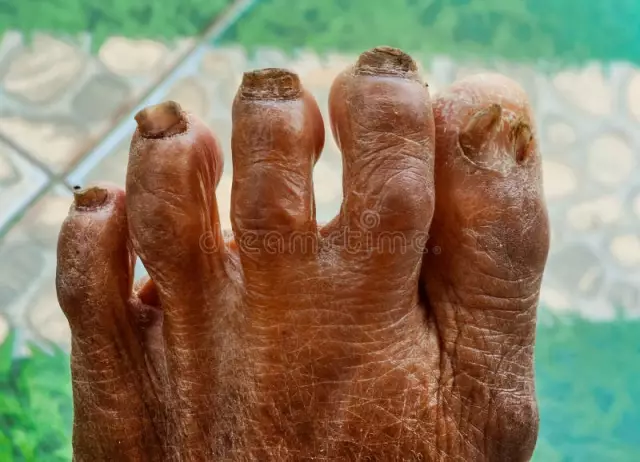- Author Rachel Wainwright [email protected].
- Public 2024-01-15 19:51.
- Last modified 2025-11-02 20:14.
Foot numbness: causes and what to do
The content of the article:
- Why is the foot numb
-
Right foot grows numb: reasons
- Physiological causes
- Osteochondrosis
- Diabetes
- Neuropathy
- Atherosclerosis
-
Left or right foot grows numb: what to do
How to help at home
-
Diagnosing the cause
Drug treatment
- Video
Numbness of the foot is an unpleasant phenomenon that almost everyone encounters. It can be caused by various reasons. The most common are uncomfortable posture, prolonged immobility of the legs, tight shoes. In such cases, numbness is short-lived, accompanied by tingling in the feet and does not pose a danger to the body. But there are other, more dangerous reasons - osteochondrosis of the spine, neuropathy, diabetes mellitus, atherosclerosis of the vessels of the lower extremities. Therefore, if your legs often go numb, you need to see a doctor and undergo an examination to identify the cause.

If the foot becomes numb often and for no apparent reason, you need to see a doctor
Why is the foot numb
Foot numbness (paresthesia) is a form of sensitivity disorder. Paresthesia occurs due to a violation of the innervation of the limbs. Two nerves are responsible for the sensory innervation of the foot:
- Tibial nerve. Its branches provide the sole's sensitivity.
- Common peroneal nerve. Provides sensitivity to the dorsum of the foot.
The defeat of sensitive fibers can also occur secondarily, against the background of circulatory disorders, when exposed to toxic substances. Thus, numbness occurs with any pathology of the nerves that provide the sensitivity of the foot - infringement of nerve fibers, neuropathy of any etiology, impaired blood supply to the nerve.
The main symptoms of paresthesia:
- tingling sensation;
- crawling feeling;
- burning;
- pain in the affected area.
Symptoms can be acute or gradual, depending on the cause.
Right foot grows numb: reasons
When the foot is numb, a person rarely seeks a doctor, since he does not associate this condition with an illness. And in vain, because numbness can be a symptom of diseases of the spine, damage to blood vessels and nerve endings. All causes of foot numbness are divided into two groups - pathological (associated with the disease) and physiological.
Physiological causes
Physiological causes of foot numbness include:
- uncomfortable posture (crossing legs over legs);
- improperly selected shoes;
- tight socks;
- for women - long walking in heels.
In all cases, numbness is caused by compression of the nerve or blood vessels. Symptoms persist for a short time and disappear after the cause is eliminated.
Osteochondrosis
Often, the limbs go numb due to pathological processes in the spine. For example, with osteochondrosis - a degenerative-dystrophic disease of the articular cartilage.
With osteochondrosis of the lumbar spine, the following symptoms occur:
- numbness of the legs;
- burning, tingling;
- pain in the lumbar spine.
Symptoms arise from pinching of the nerve roots.
Diabetes
Diabetes mellitus is a common cause of peripheral nerve damage. Due to violations of carbohydrate metabolism, blood vessels, nerves, and the brain suffer.
Due to hyperglycemia, metabolic disorders develop in peripheral nerves, which lead to the development of diabetic polyneuropathy. Pathology is manifested by the following symptoms:
- paresthesia - numbness, tingling, burning;
- decrease or loss of sensitivity;
- trophic disorders.
Nerve changes in diabetes are irreversible. It is almost impossible to restore the function of the affected nerve.
Neuropathy
Numbness is a common symptom of neuropathy (nerve damage). The causes of the disease are different:
- deficiency of B vitamins;
- alcohol exposure;
- exposure to other toxic substances (in case of chronic poisoning);
- multiple sclerosis.
The mechanism of development of neuropathy is damage to nerve fibers, as a result of which the nerves cease to perform their function.
Atherosclerosis
Numbness in the legs is often a symptom of poor blood supply to the limbs. The cause may be atherosclerosis, in which plaques form in the lumen of the vessels that impede blood flow.
The severity of symptoms in atherosclerosis depends on how much the atherosclerotic plaque closes the lumen of the vessels. The clinical signs of atherosclerosis of the lower extremities include:
- paresthesia (numbness, tingling);
- pale limbs;
- cold feet.
Localization of symptoms (thigh, lower leg, feet) depends on the place where the plaque is formed.
Left or right foot grows numb: what to do
The tactics of treating paresthesia directly depends on the cause. If the legs go numb for a short time, and the development of the symptom is associated with an uncomfortable posture, tight shoes, drug treatment is not indicated. If the symptom bothers often, it is necessary to identify the underlying disease. After the examination, specific treatment is prescribed.
How to help at home
If numbness occurs rarely and is not accompanied by other symptoms, you can get rid of it yourself. To do this, the following recommendations must be observed:
- Move. You can take a walk or just move your feet. This will improve blood circulation in the leg.
- Change your pose. Positions that compress the nerves should be avoided.
- Remove shoes and overly tight socks. This will restore normal blood flow in the feet.
- Massage your foot. Massage will help relieve the symptom faster and improve blood flow.
- Warm up your foot. If your legs start to go numb after being in the cold, you need to place your feet in a container of warm water.
In addition, it is recommended to wear comfortable shoes, do yoga regularly, and do stretching.

Most often, the feet go numb due to uncomfortable shoes
Diagnosing the cause
To identify a disease that leads to numbness, you need to be tested. The doctor prescribes a number of instrumental and laboratory tests.
| Research method | Explanation |
| Blood chemistry | It is necessary to determine the glucose level. With diabetic polyneuropathy, hyperglycemia (high blood glucose) is detected. |
| Spine X-ray | The study is prescribed if osteochondrosis is suspected. X-ray is an affordable and cheap diagnostic method, but it only detects gross changes in bone tissue. For a more specific study, magnetic resonance imaging and computed tomography are prescribed. |
| Magnetic resonance imaging (MRI) | MRI is prescribed for the diagnosis of intervertebral hernia. You can determine the location of the hernia, its size and stage. |
| Electroneuromyography | A method that records the passage of nerve impulses along a nerve fiber. With the help of neuromyography, it is possible to determine at what level the conduction of nerve impulses is impaired. |
Drug treatment
Medical treatment is selected depending on the cause. To get rid of the symptom, the underlying disease must be treated. Symptomatic treatment is not applied.
| Disease | Treatment methods |
| Osteochondrosis |
Drug treatment is complex: • non-steroidal anti-inflammatory drugs; • vitamins of group B; • muscle relaxants of central action. Also used are methods of treatment aimed at strengthening the muscle corset - therapeutic exercises, massage. |
| Diabetes |
The main direction in the treatment of diabetic polyneuropathy is the compensation of carbohydrate metabolism. For this, the following methods can be used: • diet therapy; • insulin replacement therapy; • oral hypoglycemic drugs (Metformin, Glibenclamide). It is recommended to wear orthopedic shoes, to be monitored regularly by the attending physician to prevent complications. |
| Neuropathy |
Treatment consists in eliminating the cause: • refusal to drink alcohol; • introduction of B vitamins; • detoxification measures. |
| Atherosclerosis |
Prescribed drugs that reduce blood cholesterol - statins: • Atorvastatin; • Rosuvastatin; • Simvastatin. To avoid complications, drugs are prescribed that prevent thrombus formation - Aspirin, Clopidogrel. It is also recommended to adhere to proper nutrition, quit smoking and drinking alcohol. In severe cases, drug treatment is not enough, surgical intervention is used. |
Video
We offer for viewing a video on the topic of the article.

Anna Kozlova Medical journalist About the author
Education: Rostov State Medical University, specialty "General Medicine".
Found a mistake in the text? Select it and press Ctrl + Enter.






